
Picidae, Woodpecker, is one of those charismatic bird families that everybody gets excited about. (Unless the woodpecker is drumming a hole into your garage, and then, well, it’s a different kind of excitement.) So, it is strange that while books have been written about owls and hawks, and the semi-charismatic seabirds and shorebirds, there have been few books written about woodpeckers. Woodpeckers of the World: A Photographic Guide is the first major guide to family Picidae in 20 years. The title is a bit deceptive, for while photographs are a huge part of the book, it is grounded in the 239 species accounts written by woodpecker guru Gerard Gorman. The title of the British version, Woodpeckers of the World: The Complete Guide (published by Bloombury) is more accurate. This is a comprehensive, handsome reference book that is likely to become the standard for many years.
Gorman, a Brit who now resides in Central Europe, is a naturalist and tour leader who specializes in Eastern Europe and woodpeckers. He was also an early social media adapter, and currently maintains eight nature and birding web sites, including one based on this book. He has authored Woodpeckers of Europe (2004), Birding in Eastern Europe (2006), a monograph on The Black Woodpecker (2011), and numerous popular and scholarly articles. To research this book, he traveled extensively to see as many woodpeckers as he could; this field experience was supplemented with museum research and consultations with other experts, plus a library of print material ranging from field guides to scientific papers. He writes that Bloomsbury Publishing asked him to write this book at the perfect time; it’s hard to believe Bloomsbury would consider anyone else. Gorman is the perfect woodpecker author.
Pages from the Introduction
The book opens with an all too brief summary of woodpeckers appearances in folklore and mythology. They are curiously linked to both fertility and destruction, associated with the reveler Pan and the god of war, Mars. Chapters on taxonomy, distribution, anatomy and morphology, habitat, behavior, breeding, plumage and moult, food and foraging, flight, calls, drumming, and conservation follow. This background material is a good, succinct framework within which to read the Species Accounts, particularly for birders new to woodpecker study. I particularly liked the section on Anatomy and Morphology, which explains the anatomical adaptations that enable woodpeckers to do the things they do, like drum at rates that would explode human skulls. I also enjoyed the breeding photo series, showing Downy Woodpecker eggs and then hatchlings within a breeding chamber in a tree, with only a few wood chips to support them.
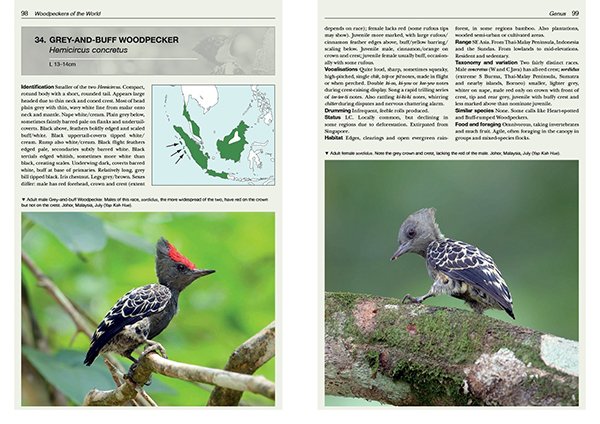 Species Accounts are organized taxonomically by genus, starting with Jynx, the atypical wrynecks that look more like nightjars, ending with Mulleripicus, the Old World, large, slim-necked woodpeckers. The taxonomy is tricky, as Gorman notes in the introduction. His determination of 239 species is the result of synthesizing recent DNA research papers and reviewing checklist authority decisions worldwide; the number is larger than the last comprehensive review of woodpeckers, volume 7 of the Handbook of the Birds of the World (2002), which came in at 216 species.
Species Accounts are organized taxonomically by genus, starting with Jynx, the atypical wrynecks that look more like nightjars, ending with Mulleripicus, the Old World, large, slim-necked woodpeckers. The taxonomy is tricky, as Gorman notes in the introduction. His determination of 239 species is the result of synthesizing recent DNA research papers and reviewing checklist authority decisions worldwide; the number is larger than the last comprehensive review of woodpeckers, volume 7 of the Handbook of the Birds of the World (2002), which came in at 216 species.
Each genus is introduced with a brief summary of the common characteristics of the group and a beautiful full-page photograph of a representative species. The Species Accounts vary in length from one to three pages. More is known about some woodpecker species than others, and Gorman points out cases where additional research is particularly needed. Five species are not illustrated, the “probably extinct” Ivory-billed and Imperial Woodpeckers, and the little-known, range-restricted Rusty-necked Piculet (tiny area in South America), Atlantic Woodpecker (Brazilian endemic), and Yellow-faced Flameback (endemic to west-central Philippine islands). Each Species Account is numbered, and introduced with a gray title box presenting common name, scientific name, and dimensions (in centimeters).
The physical description of the bird, titled “Identification”, is the longest section of each account; they are highly detailed, delineating adult and juvenile, male and female (most woodpeckers are sexually dimorphic). Given the similar colors and shapes of most woodpeckers, I have great admiration for the work Gorman put into writing each description. He differentiates between red hoods and red crests, peaks and points, barring and spotting; he knows buff from white from cream, and carefully paints upperparts, upperwings, underwings, flight feathers, napes, rumps with the most subtle differences–mostly glossy black, blackish, yellow feather shafts, mostly reddish, sometimes buff, finely streaked, barred white and brown, white moustache, black band, yellowish iris. The descriptions are all business; even Lewis’s Woodpecker rates only a “distinctive,” and you know that is because there is no other woodpecker that looks like it, not because it’s an exceptionally beautiful bird. The poetry is in the words themselves and the photographs.
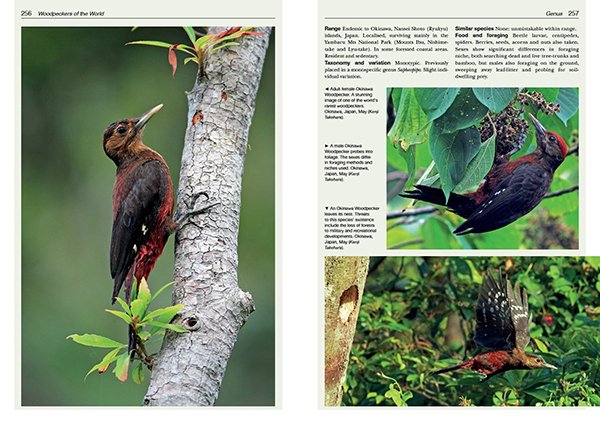 Photographs of the Okinawa Woodpecker, one of the world’s rarest.
Photographs of the Okinawa Woodpecker, one of the world’s rarest.
Gorgeous photographs, ranging in size from one-quarter to a full-page, illustrate additional identification features, behavior and habitat, and occasionally examples of races (subspecies). Credits fill two pages with the names of nature photographers from around the world, including 10,000 Birds beat writer Adam Riley. And though I know that the traditional preference for books like this is for artwork that can uniformly and accurately display all diagnostic features, I really like the photographs, and I think they are appropriate for this book. They show habitat, reflect how colors change according to light and shadow, and give the descriptions an immediacy, a sense that the woodpecker is just over there, in the Colombian rain forest, waiting for you too to photograph it. I just wish that there were more photographs of woodpeckers in flight. This is possibly an area where artwork could complement photographs in future editions.
Species Accounts also cover: Vocalizations, Drumming, Status, Habitat, Range, Taxonomy and Variation, Similar species, and Food and Foraging. Subspecies are listed and briefly described under Taxonomy, but are not always pictured. Vocalizations are presented as both transliterations and descriptions; multiple forms of vocalizations are described, often including alarm, intimate, and rattling calls. Flip the pages, read these sections and your head becomes filled with querks and sklits, peeks and wuks, kee-kee-keers and weeh-weeh-weehs.
Drumming descriptions are more extensive than the typical field guide treatment. They are, as Gorman points out, an important means of woodpecker communication and identification, “species-specific and diagnostic.” Acorn Woodpeckers’ drumming, for example, consists of “Slow, but accelerating rolls of 10-20 strikes. Sometimes interspersed with single knocks and taps.” This is one of those areas where information is sparse; there is a lack of drumming data for many endemics and species residing in obscure areas, Yellow-eared Woodpecker (SE Brazilian endemic), Stripe-cheeked Woodpecker (Panama endemic), and Red-headed Flameback (islands in the Phillipines), to name a few.
Range maps show where each species reside (green) and migrate in winter (blue) and summer (yellow), though because most woodpecker species are sedentary, most of the ranges are in green. The maps are larger than those in field guides, but only give an approximation of distribution. Looking at the map for Red-headed Woodpecker, for example, you would think that the bird could be found as easily in New York as in Georgia. No political boundaries are indicated, which makes using the book awkward when the map and the textual range information are on different pages. Still, maps for species like the Okinawa Woodpecker, a rare woodpecker mainly found in Yambaru Mountains National Park in Okinawa, Japan, bring home visually the minute ranges of some of these species.
Woodpeckers of the World is a carefully designed book, with attention paid to making the reading experience efficient yet enjoyable through visual and textual indicators and design. Each species account is introduced with a gray title box featuring a dark-gray silhouette of a bird from the genus; page headings on the upper right-hand page of each spread spell out the genus. If you are a browser like me, it’s hard to get lost. Within the accounts, uniform bolded headings indicate specific topics and arrows next to each photo caption make sure you know which caption goes with which photo.
Back of the book material includes an almost-comprehensive nine-page Bibliography of books and articles published after 2002. (Readers are told to consult Handbook of Birds of the World and Woodpeckers: A Guide to the Woodpeckers, Piculets and Wrynecks of the World by Hans Winkler, David Nurney, David A Christie (1995) for earlier literature.) I say almost-comprehensive because the bibliography is heavily tilted towards scientific literature. For example, The Auk article on the recently discovered film documentation of the Imperial Woodpecker is listed, but Tim Gallagher’s Living Bird article and book on the discovery, written for a broader audience, are omitted.
The Index lists species by full popular name and scientific name. For example, Golden-cheeked Woodpecker is listed under G. There is no listing, as there is in Handbook of the Birds of the World, under Woodpecker or Piculet or Flicker or Wryneck. This makes it very difficult to research woodpeckers by genus. Let’s say you’ve seen a bird that you think is a flicker, but you’re not sure which species. In fact, you’re not even sure of the names of flicker species. How do you look it up? If there are future editions of this title, as Gorman hopes, I hope this is changed.
Woodpeckers of the World: A Photographic Guide is a marvelous reference book for birders and naturalists who want to learn more about the diversity of the family Picidae. I hesitate to call it an identification guide. I wouldn’t use it as a tool for determining identification, but I would use it to learn more about species I’ve already identified. Especially for drumming, food and foraging information, and to see what other species belong to the same genus and where. It is a far less expensive, more compact, and up-to-date alternative to volume 7 of Handbook of the Birds of the World (though of course it does not include the ornithological essays). It’s also a visually pleasurable book to peruse, not as large as a coffee table book, but as colorful and impressive as the best. There is something fascinating about looking at the images of these birds, so much alike in shape and behavior yet so different in the details. At $49.5 (discounts from the usual sources), it is a book birders might want to put on their birthday or holiday lists. This is a worthwhile addition to birding literature, and I hope that Gorman and his publishers are able to keep it updated in print or online.
————
Woodpeckers of the World: A Photographic Guide by Gerard Gorman.
Firefly Books, 2014; 528 pages, 6.2 x 1.5 x 9.5 inches.
ISBN-10: 177085309X; ISBN-13: 978-1770853096.
$49.95 (less from the usual suspects)
British version:
Woodpeckers of the World: The Complete Guide.
Publisher: Bloomsbury Publishing, 6.7 x 1.3 x 9.4 inches
ISBN-10: 1408147157; ISBN-13: 978-1408147153.
£35.00.


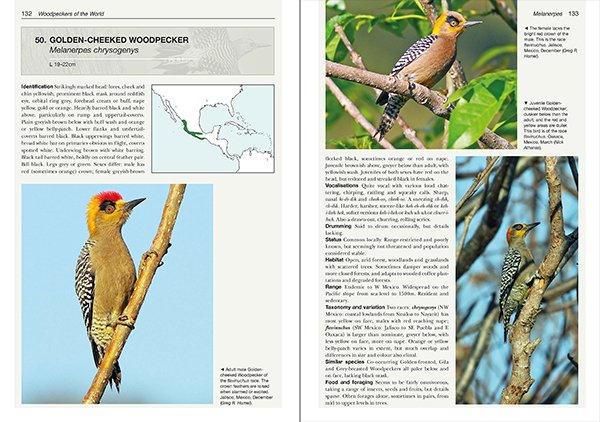
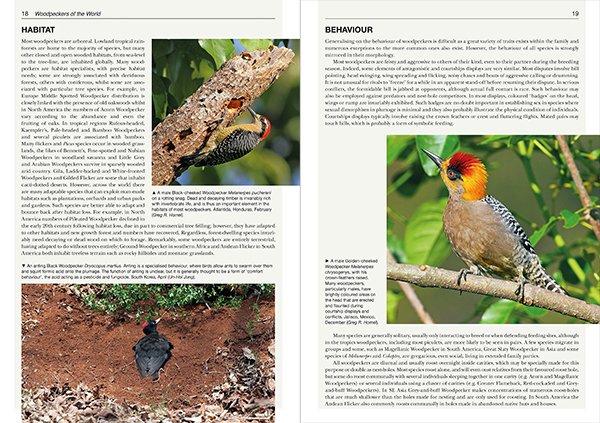
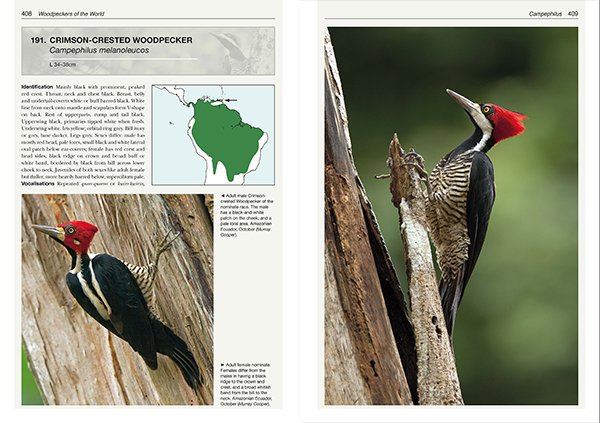
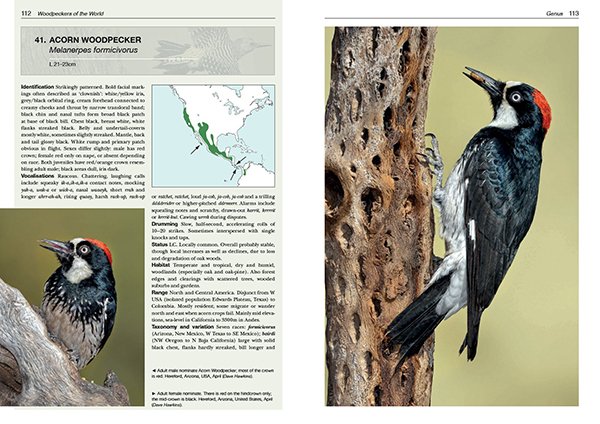
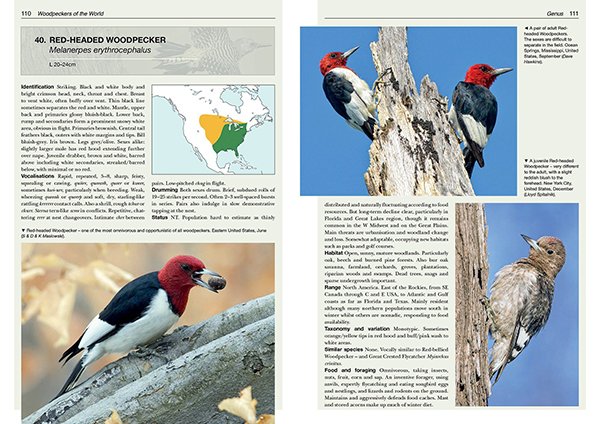
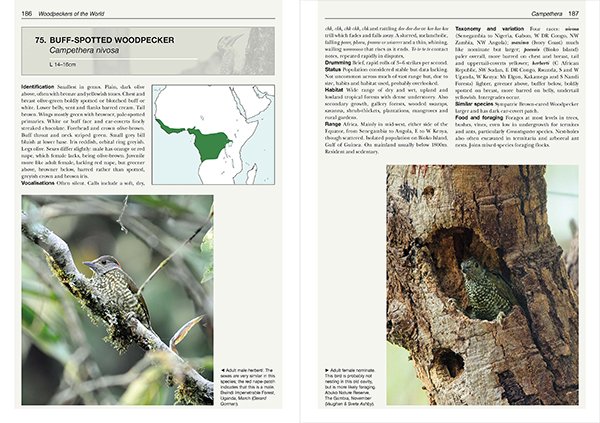











Leave a Comment